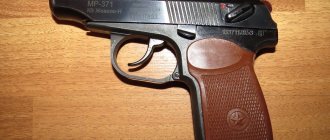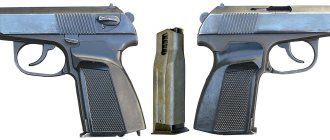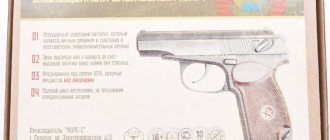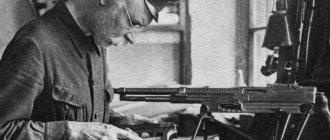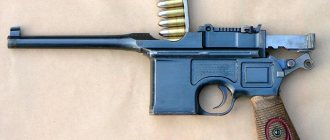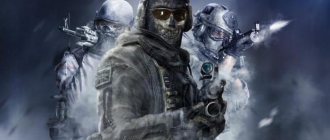Pistols – PM and TT
The first Soviet self-loading pistol TT (Tula Tokarev) was developed in 1930.
F.V. Tokarev and put into service three years later. The pistol was excellent and replaced the obsolete Revolver and other revolvers produced by foreigners. But Tokarev did not create his TT from scratch. The prototype of the Soviet pistol was the FN Model 1903, a pistol designed back in 1902 by John Browning, an American gunsmith who worked in Belgium. The design of the Colt-Browning M1911 was also taken into account. The result was a high-quality and inexpensive weapon chambered for the German 7.62 mm cartridge. The pistol was modified many times, it remained in service until the 1960s, and then “served” in the Soviet police, border guards, and remained in reserve warehouses.
In the army, the TT was gradually replaced by the PM (Makarov pistol) - a 9 mm self-loading pistol. Nikolai Makarov's invention was adopted in 1951, and then it became the most famous Russian pistol, both army and police weapons. The TT was somewhat outdated by that time, but the new pistol had a number of advantages - it was more compact, and its bullets had greater stopping power, and it was also highly reliable. The German Walther PP from 1929, which had already earned popularity around the world, was taken as the basis. In fact, Makarov finalized the design of the Walter PP, improving and simplifying what could be improved with modern technologies - the strength of parts, ease of maintenance, safety mechanism and other parts. The Soviet gunsmith eliminated a slight delay when firing, characteristic of the Walter. PM is also more durable and cheaper. No wonder it was used in the armies of Russia and other countries even after 1991.
Another title
Many soldiers claim that the best comrade is a senior sergeant. It is interesting that the next army rank is assigned to a warrior on the day of completion of his military service in the previous military rank, if he is in a military position for which the state provides an army rank equal to or higher than the military title assigned to the warrior.
An army rank may be given to a serviceman prematurely for personal special merits, but not higher than the army rank predetermined by the state for the army post he occupies.
The assignment of military ranks to contract soldiers is carried out:
- to cadet or corporal - commanders of a regiment and individual battalions, as well as the commander of a detachment (individual military unit);
- up to senior sergeant - by regimental commanders and their equals;
- to senior sergeant - military commanders of formations.
"Mosinka" and Kalashnikov assault rifle
More serious Russian “guns” are also inspired by foreign experience. For example, the Maxim machine gun, associated with the Soviet army during the Civil War and the beginning of the Great Patriotic War, was designed by the British engineer Hiram Maxim, and Russia produced it at the Tula Arms Plant under license. A more original weapon was the three-line Mosin rifle of 1891. The “three-line” served Russia until the mid-20th century. When creating it, Sergei Mosin relied on some design discoveries of the Austro-Hungarian gunsmith Mannlicher and on the 3-line rifle of the Belgian L. Nagan.
But even the Mosinka cannot compare in fame and distribution across our planet with the good old AK. The legendary weapon was designed by M.T. Kalashnikov in 1947, and was adopted by the Soviet army in 1949. AKs of various types and modifications have spread all over the world, it is even depicted on the flags of four third world countries, and according to statistics, for every 4th person on the planet there is one AK. There are more than 17 million of them in Russia alone. And everywhere this machine gun is known as a Russian weapon. But he was not spared the influence of the German arms industry. During the war, Soviet designers carefully studied all the new weapons that they managed to capture at the front. In 1943, they studied the captured German MKb.42(H) assault rifle, and then its continuation, the StG-44 (Sturmgewehr) by Hugo Schmeisser. This first mass-produced machine gun, which the Germans produced in the amount of 450 thousand units, became the prototype of the AK. It is even very similar in shape to him. Kalashnikov took from him the use of an intermediate caliber - changed the caliber (7.62 instead of 7.92 mm), added an original bolt system, made a number of design changes (borrowed some from other Russian designers) and - done! The machine gun, which largely “cited” the successful design solutions of German, American, British and Russian gunsmiths, turned out excellent and was adopted for service.
How to become a military man in Russia
Military specialized institutions have many specializations, and the choice of a narrow specialty depends only on those wishing to serve in the Armed Forces.
Higher educational institutions can become cadets
- Guys from 16 to 22 years old with Russian citizenship. If you have a certificate of secondary or vocational education. Subject to a clean history with the Ministry of Internal Affairs, i.e. no criminal record.
- For persons serving in the Armed Forces by conscription, enrollment is possible after half of their service period, until they reach 24 years of age. To submit documents, military personnel must submit a report to the commander of the military unit by April 1.
The opportunity to become a military man is available to any citizen of our State, subject to excellent health, unshakable moral principles and clear life principles. After military service, the commander will definitely offer young guys to join the ranks of daredevils and brave servicemen.
Until recently, female employees often occupied military positions as kitchen workers, nurses, and signalmen.
For girls
In our country, girls can serve in the Armed Forces only under a contract, which she enters into at her own request. If a girl has an education related to the military department, for example: a surgeon or paramedic, or maybe a signalman or others, then she can be mobilized in the event of martial law in the country.
To conclude a contract, a young girl must contact the military registration and enlistment office at the place of registration and go through all the necessary procedures. They enter into a contract with adult girls who have completed secondary or specialized education.
Soviet atomic bomb
The first Soviet atomic bomb (RDS-1) is certainly an achievement of Soviet nuclear physicists (I. Kurchatov and others). After all, even copying something is not easy. And basically they had to do copying - after 1945, when the United States created and used nuclear weapons for the first time in history, there was an urgent need to reduce the gap. Soviet designers and intelligence officers used the American experience in creating the atomic bomb, supplementing it with captured German developments (as did the Americans themselves). So, Soviet physicists went to Peenemünde (where the Germans produced V-2), studied what the Germans had done, brought tons of enriched uranium to the USSR, which accelerated their own developments. RDS-1 is very similar to the first American atomic bomb, both in form and content, but it also contains Soviet discoveries: a unique ballistic body and electronics. In 1949, the bomb was finally ready. Successful tests were carried out at the Semipalatinsk test site, the USSR mastered nuclear weapons. This happened three years earlier than expected by American experts. From this point on, the Cold War became protracted - both sides became too strong to attack each other.
Despite the fact that many models of small arms and other weapons have foreign roots, Russian designers have always improved them so that they become the best weapons in their class at the world level.
Konstantin Dmitriev
OGPU leadership
The Chairman of the OGPU was appointed by the Presidium of the Central Executive Committee of the USSR and was a member of the Council of People's Commissars of the USSR with the right of an advisory vote.
| Dzerzhinsky F. E. (XI. 15, 1923 - VII. 20, 1926); |
| Menzhinsky V. R. (30. VIII. 1926 - 10. V. 1934). |
Tasks of the OGPU
The United State Political Directorate (OGPU) was given the following tasks: - uniting the revolutionary efforts of the union republics to combat political and economic counter-revolution, espionage and banditry;
History of the OGPU
In connection with the formation of the USSR, on November 2, 1923, the Central Executive Committee of the USSR formed the United GPU (OGPU) under the Council of People's Commissars of the USSR. The OGPU, in comparison with the GPU, had a higher status, being the all-Union People's Commissariat. In the union republics, the OGPU had its own representatives, and in the army - special departments. The border troops were subordinate to the OGPU. In 1926, the Main Directorate of Border Guards and OGPU Troops was formed. In 1929, part of the forced labor camps was transferred to the jurisdiction of the OGPU. Before this, the Cheka-OGPU had their own special camps for political prisoners. With the help of the Foreign Department (INO), created on December 20, 1920, the OGPU conducted intelligence work in foreign countries. In the 1920s, the expansion of the extrajudicial rights of the OGPU continued. The resolution of the USSR Central Executive Committee of November 15, 1923 gave its board the right to consider cases of sabotage using all measures of repression. On March 28, 1924, by resolution of the Central Executive Committee of the USSR, a Special Meeting was formed under the OGPU to carry out administrative expulsions, exiles and imprisonment in concentration camps. It consisted of 3 members of the OGPU board with the participation of the USSR Prosecutor. On May 3, 1926, the Presidium of the Central Executive Committee of the USSR granted the Special Meeting under the OGPU the right of repression against those suspected or convicted of smuggling. On August 13, 1926, the Presidium of the Central Executive Committee supplemented the resolution of March 28, 1924 with the right of the OGPU to prohibit those who had served an administrative sentence from entering Moscow and the Moscow province. 4 April 192? The Presidium of the Central Election Commission granted the right to “examine cases of sabotage, arson, explosions, damage to machine installations, both with and without malicious intent, out of court, up to the application of capital punishment.” On June 9, 1927, the same rights were granted in relation to cases against White Guards, spies and bandits. On February 3, 1930, the Presidium of the Central Executive Committee gave the OGPU the right, during the period of the campaign to “liquidate the kulaks,” to delegate its powers for extrajudicial consideration of cases to the regional and regional bodies of the OGPU. In this case, the “troikas” included representatives of the regional committees and regional committees of the All-Union Communist Party of Bolsheviks.
In connection with the liquidation of the NKVD in the republics, the Central Executive Committee and the Council of People's Commissars of the USSR adopted a resolution “On the management of the OGPU bodies in the activities of the police and criminal investigation.” The Main Inspectorate for the management of police and criminal investigation activities was formed as part of the OGPU. By decree of the Central Executive Committee and Council of People's Commissars of the USSR dated December 27, 1932, the Main Directorate of the Workers' and Peasants' Militia was formed under the OGPU of the USSR. The OGPU bodies resolved issues of issuing foreign passports and regulated the legal status of foreigners.
Examples of typical designs
Mosin rifle mod. 1891/30 (Russia, USSR)
The firing pin and the coiled cylindrical mainspring are located in the bolt. The mainspring is compressed when the bolt is unlocked; when locked, the firing pin rests on the sear. It is possible to cock the firing pin manually with the bolt closed; to do this, you need to pull the trigger back (in this case, the trigger is the tip screwed onto the shank of the firing pin). To engage the safety, the trigger must be pulled back as far as it will go and turned counterclockwise.
Nagant revolver arr. 1895 (Belgium, Russia, USSR)
Nagan system revolver. USM diagram. The trigger is cocked
The trigger trigger is double-action (a single-action version was also produced), the firing pin is hinged on the trigger, the mainspring is plate-type, double-action, located in the handle. The sear is integral with the trigger. There is no safety, but when the trigger is not pressed, a special part prevents the firing pin from coming into contact with the primer. When cocking, the hammer also activates a specific locking mechanism that moves the revolver drum forward, and the trigger, with a special protrusion, stops the drum from rotating.
Pistol Colt M1911 (USA)
Trigger trigger, single action. The mainspring is a twisted cylindrical one, located in the handle behind the magazine; the force on the trigger is transmitted through a rod. The firing pin is spring loaded to prevent accidental firing. The trigger moves longitudinally in the grooves of the pistol frame. There are two fuses: one blocks the sear and bolt, the second blocks the trigger rod. When the fuses are turned on, the trigger can remain cocked and locked, this compensates for the insufficient efficiency of the single-action trigger. In addition, a safety cock is provided.
TT pistol (USSR)
Incomplete disassembly of the TT pistol. On the right between the frame and the return spring there is a trigger block
Trigger trigger, single action. The mainspring is a twisted cylindrical one, located in the trigger cavity. The firing pin is spring loaded to prevent accidental firing. The trigger moves longitudinally in the grooves of the pistol frame. There is no fuse as such; its role is played by the safety cocking of the hammer. The design feature is that the entire trigger, except for the trigger and firing pin, is made in the form of a single easily removable unit (“block”).
PK machine gun (USSR)
A trigger with a recoil spring provides only automatic fire. The combat cock is located on the bolt frame, and the firing pin is connected to it. When, after locking the bolt, the bolt frame continues to move forward, the firing pin, under its action, moves along the channel in the bolt frame and breaks the primer. In the tank version of the machine gun (PKT), instead of a trigger, an electromagnetic trigger mechanism (electric trigger), activated by a button, is installed.
PPSh submachine gun (USSR)
Typical for mass-produced submachine guns, a simple trigger with a recoil spring, the firing pin is rigidly fixed in the bolt, and the cocking mechanism is located on the bolt. There is a translator that allows you to conduct single or automatic fire. The safety lock blocks the movement of the shutter.
AKM assault rifle (USSR)
The trigger trigger is hidden in the receiver; cocking is possible only by pulling the bolt frame back. The trigger has three sears: the first, made integral with the trigger, keeps the hammer cocked when the trigger is released; the second (single-fire sear) holds the trigger when the trigger is pressed in single-fire mode. Due to this, a disconnector is not required; the third (self-timer sear) in automatic fire mode holds the trigger until the bolt closes; release from this sear is ensured by the bolt frame when it reaches its extreme forward position. To reduce the rate of automatic firing, the movement of the trigger after release is somewhat slowed down by a special part - a retarder. The mainspring is spiral, the firing pin is located in the bolt channel. The safety, combined with the fire mode translator, blocks the trigger and limits the movement of the bolt frame.


